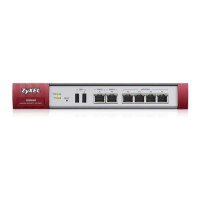Chapter 6 AP Management
ZyWALL Series CLI Reference Guide
59
6.3 General AP Management Commands
The following table describes the commands available for general AP management. You must use the
configure terminal command to enter the configuration mode before you can use these
commands.
ap_description
The AP description. This is strictly used for reference purposes and has no effect on any other
settings. You may use 1-31 alphanumeric characters, underscores(
_), or dashes (-), but the
first character cannot be a number. This value is case-sensitive.
sta_mac
The MAC address of the wireless client. Enter 6 hexidecimal pairs separated by colons. You
can use 0-9, a-z and A-Z.
Table 13 Input Values for AP Management Commands (continued)
LABEL DESCRIPTION
Table 14 Command Summary: AP Management
COMMAND DESCRIPTION
[no] capwap activate
Enables or disables the AP controller service.
capwap ap <mac address> [no]
airtime-fairness activate
Enables airtime fairness on the specified AP.
The no command disables airtime fairness on the AP.
capwap ap ap_mac
Enters the sub-command mode for the specified AP.
slot_name ap-profile
profile_name
Sets the radio (slot_name) to AP mode and assigns a created
profile to the radio. See Section 6.1.1 on page 57 for more
information on different modes.
no slot_name ap-profile
Removes the AP mode profile assignment for the specified
radio (slot_name). See Section 6.1.1 on page 57 for more
information on different modes.
slot_name monitor-profile
profile_name
Sets the specified radio (slot_name) to monitor mode and
assigns a created profile to the radio. See Section 6.1.1 on
page 57 for more information on different modes. See also
Section 9.2 on page 79 for more information on rogue APs
and friendly APs.
no slot_name monitor-profile
Removes the monitor mode profile assignment for the
specified radio (slot_name).
slot_name {root-ap | repeater-ap
} zymesh-profile_name
Sets the specified radio (slot_name) to root AP or repeater
mode and assigns a created ZyMesh profile to the radio.
See Section 6.1.1 on page 57 for more information on different
modes.
See also Section 9.6 on page 98 for more information about
ZyMesh.

